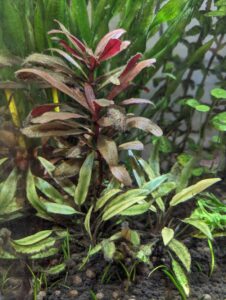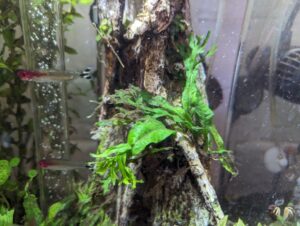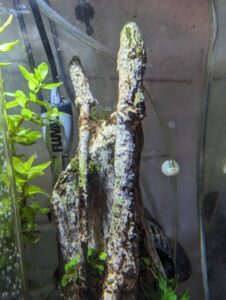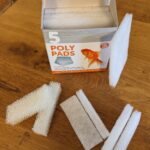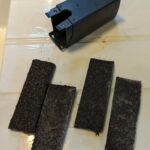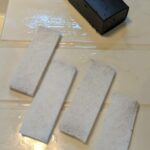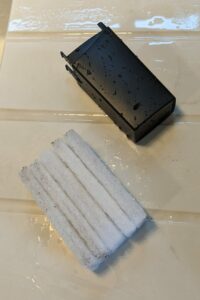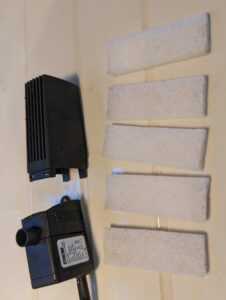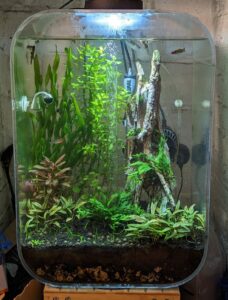Usually I don’t have a big problem with debris in the Fireplace Aquarium – generally that will settle out onto the substrate and can be removed effectively by resuspension and vacuuming during a large water change. When removing a lot of plants, however, you can wind up with “neutral density” debris – debris with nearly the same density as water. It can take a lot of water changing to remove this debris which won’t settle to the bottom and instead tends to stick to plants where it looks unsightly and can block light and gas exchange. This type of suspended fine debris can be removed by water polishing using a filter.
EHEIM miniUP filter for water polishing
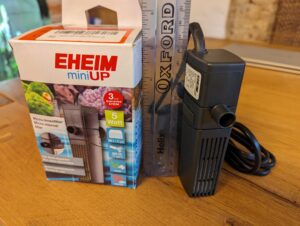
I picked up an inexpensive EHEIM miniUP filter to help remove fine floating debris. This small internal filter can be temporarily installed when needed for periodic water polishing. I installed the miniUP, dislodged settled debris using the “blast it with a turkey baster” technique, and let the filter do its job.
Build quality not so great
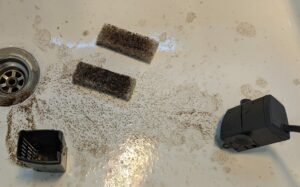
The build quality of the miniUP is, to be honest, not super great. The sponge containing half separates arguably too easily from the pump half. The suction cups that hold it to the aquarium wall are very strong such that if you’re not careful the filter will come apart spontaneously when you try to move or remove it. There are two default sponges that come stacked together inside the filter. In my case, one wasn’t inserted all the way correctly and had a small fold in the bottom. Also, the default sponges are very coarse and work to filter out large debris only. That’s great but it’s not really what I needed. There is a small gap between the stacked sponges and the walls of the filter body where water could go through the filter without necessarily passing through the sponges. People looking to use the EHEIM miniUP as an everyday filtration device in their nano-aquarium might well be disappointed. That all said, you can see that the sponges, which are completely white before use, have picked out a good amount of mostly larger particulate matter.
Homebrewed EHEIM miniUPGRADE
Fortunately, it is easy (and inexpensive) to rectify the two biggest problems of the miniUP – the sponges that are too coarse and that leave open gaps in the water path – by swapping out the default sponges for something better. In this case I used replacement ‘poly pads‘ designed for a Juwel internal filter. These were readily available at the pet store and very easy to cut to the same size as the miniUP default sponges. The poly pads are thinner so I packed four of them into the miniUP filter housing instead of the two default sponges.
The denser poly pads did a great job of removing the finer particulate debris. Even so, after they get wet the poly pads do pack down a bit so four of them turned out to be not enough. Five of them can pack in better to seal all the gaps.
After packing in a fifth poly pad and more goes with the turkey baster the water polished up sufficiently that not all the surface of the poly pads was completely black. That’s job done! The poly pads rinse off with clean water to ready-for-next-time-use condition as well as did the original sponges.
Install the filter upside-down for better filtration
EHEIM miniUPGRADE in action – before and after
Pro tip: the EHEIM miniUP is more effective at filtration if you install it upside down. When installed in the obviously right-side-up orientation, the outflow water jet is on top with the filtration intake on the bottom. This doesn’t make much sense because after you resuspend the particulate debris using a turkey baster, the debris will all be swirling around and gradually settling from the top down to the bottom. With the filter in the “normal” orientation the debris is blasted away from the filter by the outflow before it has a chance to reach the filter. When installed upside down, the first opportunity the debris has to encounter the miniUP is with the business end of the filtration intake – that’s what you want.
The other advantage to installing the miniUP in upside-down orientation is that when you’re removing the filter you don’t need to unplug it first – the filter can keep running as you lift it out of the water. This way debris doesn’t have a chance to “back flow” back out of the filter pads before removal. You can’t do this with the miniUP installed in the UP orientation because if you do water will be able to shoot out of the aquarium as you lift out the filter.
